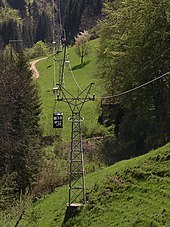Wasserfallenbahn
The Wasserfallenbahn , also known as the Reigoldswil-Wasserfallen cable car , is a gondola lift in the Chain Jura in Basel . Until the opening of the gondola to the Weissenstein (Jura) on December 19, 2014, it was the only gondola in north-western Switzerland . It leads from the valley station in Reigoldswil to the mountain station, which is located in the Wasserfallen region, a mountain range of the Jura.
Historic Wasserfallenbahn (1955-2006)
The railway was built in 1955 on behalf of Autobus AG Liestal (AAGL) and opened on March 2, 1956. This was preceded by a license application for construction submitted by the AAGL on May 12, 1953, and the license was finally granted on December 31, 1953. Almost the same project failed in the planning phase in 1931.
The company Gerhard Müller Dietlikon was commissioned with the construction . The Vogelberg ski lift was also built in 1956, followed by the Chellenchöpfli ski lift in 1969. However, both facilities were canceled in the early 1990s due to a lack of snow.
In 1994 AAGL donated the cable car in need of renovation to an independent foundation for the Reigoldswil-Wasserfallen cable car . In the following year, the operating license expired and the supervisory authority made the approval for continued operation dependent on a complete renovation. However, this renovation would have exceeded the company's financial resources so far that the railway would have had to be shut down. In the end, a compromise was negotiated that required significantly fewer measures and requirements for continued operation. The railway could therefore continue to operate.
In the long run, however, the railway was too outdated and in a too dilapidated condition, which is why the railway was demolished in 2006 and replaced with a new one in the same place. The historic Wasserfallenbahn was therefore in operation for a little more than 50 years.
The historic Wasserfallenbahn was 1933 meters long and climbed a total of 384 meters between the valley station at an altitude of 544 meters above sea level and the mountain station at an altitude of 928 meters above sea level. A total of twelve supports were required for the route. The maximum gradient was 61.6 percent.
There were a total of 36 cabins with a capacity of four passengers each. The curb weight of each individual cabin was 180 kilograms. The gondolas reached a speed of 2.3 meters per second, which corresponds to approximately 8.3 km / h. The travel time in each direction was 15 minutes, the capacity of the entire cable car was 320 passengers per hour and direction.
New construction of the Wasserfallenbahn (2006 to today)
The old railway increasingly no longer met the safety regulations. It was therefore decided to demolish the railway and build it again. The new building was co-financed by the Swiss Alpine Club, as its Waldweidhütte largely owes its turnover to the cable car. After a donation marathon in autumn / winter 2005 enough money could be collected for a new building. As a result of resistance from nature conservation groups and lack of money, a planned extension to the Vogelberg failed, so that the top and bottom stations were rebuilt at the same location.
The runway was torn down after Easter 2006 and rebuilt from May to September 2006. The AAGL provided a rail replacement during the construction period. For this purpose, an older car was used, which could also drive on unpaved road sections.
The cable car route is 1941 meters long and overcomes an altitude difference of 384 meters, with the valley station 541 meters above sea level and the mountain station 925 meters above sea level. A total of eleven supports that are up to 40 meters high were erected for the route. The locations of the mountain and valley stations are identical to the 1956 railway.
A total of 26 cabins are used for operation, each with a capacity of six seats or a load capacity of 480 kilograms. The gondolas, which can reach speeds of up to 18 km / h, each take eight minutes to travel in one direction. This means that the newly built Wasserfallenbahn can transport around 650 people per hour and direction.
future
The extension project to the Vogelberg continues. The current mountain station has already been structurally designed so that it could be converted into an intermediate station for a two-section gondola lift.
Individual evidence
- ^ History of the Autobus AG Liestal with a short note on the opening
- ^ History of the AAGL
- ↑ Very detailed articles with many facts about the old Wasserfallenbahn
- ↑ Technical data of the new Wasserfallenbahn


